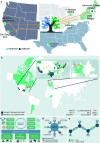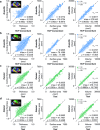brainlife.io: a decentralized and open-source cloud platform to support neuroscience research
- PMID: 38605111
- PMCID: PMC11093740
- DOI: 10.1038/s41592-024-02237-2
brainlife.io: a decentralized and open-source cloud platform to support neuroscience research
Erratum in
-
Author Correction: brainlife.io: a decentralized and open-source cloud platform to support neuroscience research.Nat Methods. 2024 Jun;21(6):1131. doi: 10.1038/s41592-024-02296-5. Nat Methods. 2024. PMID: 38714873 Free PMC article. No abstract available.
Abstract
Neuroscience is advancing standardization and tool development to support rigor and transparency. Consequently, data pipeline complexity has increased, hindering FAIR (findable, accessible, interoperable and reusable) access. brainlife.io was developed to democratize neuroimaging research. The platform provides data standardization, management, visualization and processing and automatically tracks the provenance history of thousands of data objects. Here, brainlife.io is described and evaluated for validity, reliability, reproducibility, replicability and scientific utility using four data modalities and 3,200 participants.
© 2024. The Author(s).
Conflict of interest statement
F.P. received a Microsoft Faculty Fellowship, and Microsoft Azure sells Cloud Services. S.T.B. works for Hewlett-Packard Enterprise, which sells computing services. A.D.B. is an employee of BioSerenity, a company that develops medical devices to help diagnose and monitor patients with chronic diseases. S.H. is an employee of SHEGEL SPRL/BVBA a legal firm with expertise in data protection law. The other authors declare no competing interests.
Figures










Update of
-
brainlife.io: A decentralized and open source cloud platform to support neuroscience research.ArXiv [Preprint]. 2023 Aug 11:arXiv:2306.02183v3. ArXiv. 2023. Update in: Nat Methods. 2024 May;21(5):809-813. doi: 10.1038/s41592-024-02237-2. PMID: 37332566 Free PMC article. Updated. Preprint.
References
MeSH terms
Grants and funding
- U24 DA041147/DA/NIDA NIH HHS/United States
- U01 DA051039/DA/NIDA NIH HHS/United States
- RF1MH13370/U.S. Department of Health & Human Services | National Institutes of Health (NIH)
- U01 DA041093/DA/NIDA NIH HHS/United States
- U24 DA041123/DA/NIDA NIH HHS/United States
- U01 DA051038/DA/NIDA NIH HHS/United States
- U01 DA051037/DA/NIDA NIH HHS/United States
- U01 DA051016/DA/NIDA NIH HHS/United States
- U01 DA041106/DA/NIDA NIH HHS/United States
- U01 DA041117/DA/NIDA NIH HHS/United States
- U01 DA041148/DA/NIDA NIH HHS/United States
- 1445604/National Science Foundation (NSF)
- 226486/Z/22/Z/Wellcome Trust (Wellcome)
- R01 EB030896/EB/NIBIB NIH HHS/United States
- U01 DA041174/DA/NIDA NIH HHS/United States
- 1916518/National Science Foundation (NSF)
- U01 DA041120/DA/NIDA NIH HHS/United States
- R01 MH126699/MH/NIMH NIH HHS/United States
- U01 DA051018/DA/NIDA NIH HHS/United States
- 2005506/National Science Foundation (NSF)
- U01 DA041134/DA/NIDA NIH HHS/United States
- U01 DA041022/DA/NIDA NIH HHS/United States
- 1912270/National Science Foundation (NSF)
- U01 DA041156/DA/NIDA NIH HHS/United States
- U01 DA050987/DA/NIDA NIH HHS/United States
- 1636893/National Science Foundation (NSF)
- U01 DA050989/DA/NIDA NIH HHS/United States
- R01 EB029272/EB/NIBIB NIH HHS/United States
- U01 DA041025/DA/NIDA NIH HHS/United States
- 1541335/National Science Foundation (NSF)
- UM1 NS132207/NS/NINDS NIH HHS/United States
- R01 EB027585/EB/NIBIB NIH HHS/United States
- U54 MH091657/MH/NIMH NIH HHS/United States
- U01 DA041089/DA/NIDA NIH HHS/United States
- 2232628/National Science Foundation (NSF)
- U01 DA050988/DA/NIDA NIH HHS/United States
- 2004877/National Science Foundation (NSF)
- U01 DA041028/DA/NIDA NIH HHS/United States
- U01 DA041048/DA/NIDA NIH HHS/United States
- 1734853/National Science Foundation (NSF)
- WT_/Wellcome Trust/United Kingdom
- RF1 MH133701/MH/NIMH NIH HHS/United States
- P41 EB017183/EB/NIBIB NIH HHS/United States
LinkOut - more resources
Full Text Sources

